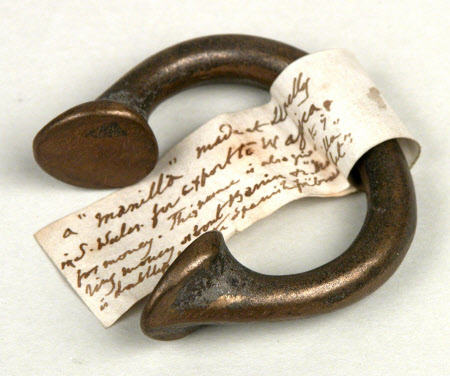Brass object
Category
Metalwork
Date
Unknown
Materials
brass
Measurements
60 mm (Diameter)
Order this imageCollection
Calke Abbey, Derbyshire
NT 289483
Summary
Manilla, a horseshoe-shaped brass bangle with flattened, flared ends. The word ‘Manilla’ originates from the Latin ‘manus’ (hand), or ‘monilia’ or ‘monile’, the plural for necklace, and was traditionally a form of commodity money used widely in West Africa, made from copper or less valuable brass. The size and the type of metals used determined the value of one manilla and they were an accepted currency until the end of the 19th century. The attached label reads: “A 'Manilla' made at Llanelly in S. Wales for export to W. Africa for money”. Soon after the British entered the Transatlantic slave trade, with the improvement of the brass and copper industry, multiple companies across Britain were able to produce their own manillas. Near Swansea, in the small coastal town of Llanelli, brass production commenced in 1833 and some factories produced manillas exclusively for the slave trade in West Africa.
Provenance
Transferred to the National Trust by the Treasury in lieu of CTT in 1985 with an endowment provided by the NHMF.
Marks and inscriptions
Label fixed to bangle: A 'Manilla' made at Llanelly in S. Wales for export to W. Africa for money.
